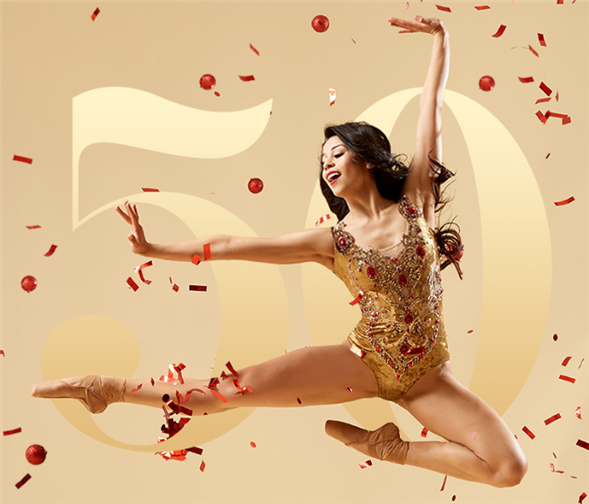Translate Page

How the venerable troupe's 50th anniversary honors its history while looking ahead
---
Reaching a 50th anniversary is a huge milestone for any American dance company. But for the Dance Theatre of Harlem, its half-century celebration at City Center (April 10-13) represents an against-the-odds achievement as one of the first and most lauded black ballet troupes in the nation.
DTH was a passion project for Arthur Mitchell, the first black principal dancer with New York City Ballet. In the late '60s, he was a dance world luminary, performing important roles created for him by George Balanchine and others, appearing on TV and making guest appearances around the world. But the 1968 assassination of Martin Luther King Jr. jolted Mitchell and changed his trajectory. Having recently helped found a dance company in Brazil, the Harlem native realized he wanted to refocus his attention closer to home. So he decided to bring the art and discipline of ballet to a population that had little access to it: the residents of the neighborhood where he was raised
He joined forces with Karel Shook, a highly regarded ballet teacher, and by February 1969, Dance Theater of Harlem was incorporated, and a school was up and running in a converted garage. Ballet may not have been a priority for most Harlem youngsters, but the eloquent, charismatic and dynamic Mitchell won them over and the studios soon buzzed with activity. Once he had trained a pool of talented dancers, Mitchell launched his company.
Virginia Johnson was one of DTH's earliest dancers, and she has served as the company's artistic director since Mitchell handed her the reins in 2011. As the anniversary approached, she consulted with him to plan the occasion. "Arthur and I talked about this 50th anniversary quite a bit over the past two years," she says. "He wanted to make sure that we were celebrating it in the way he wanted it to be celebrated!"
Sadly, Mitchell did not live to see the festivities: He died last September at age 84. But a month earlier, he had been in the DTH studios, looking in on rehearsals for Tones II, a revamped version of his 1971 piece Tones with music by Tania Leon.
"I told him I wanted DTH to perform something of his as part of the anniversary season," Johnson says. "Not only was he the founder, but he shaped us artistically. Though he didn't set out to be a choreographer, he had a company, and in the beginning we didn't have money and he needed dances. So he choreographed for us. Tones was a work he really wanted to revisit."
Da' Von Doane, who has been dancing with DTH for over a decade, cherished the opportunity to collaborate with Mitchell in the studio last year. Doane joined DTH's smaller ensemble in 2008 while the main company was on an extended hiatus due to financial woes. He's been part of the reformed troupe since its 2012 launch, so he says working with Mitchell "was a bittersweet full-circle moment for me."
Several other works Mitchell created during DTH's formative years will be performed at the company's gala on April 10, including Bach Passacaglia, which he choreographed for his students to perform when he received a Kennedy Center Honor in 1993. While the gala offers a whirlwind tour through the company's history -- including an excerpt from its Afro-Creole take on Giselle, Creole Giselle -- the programs on April 12 and 13 nod to the past while resolutely looking toward the future. The lineup includes Geoffrey Holder's pageant-like Dougla, a DTH mainstay in earlier decades that was successfully revived last year; Annabelle Lopez Ochoa's vivid Balamouk, which debuted this past fall; and resident choreographer Robert Garland's latest work, Nyman String Quartet #2.
A Juilliard School graduate who danced with DTH, Garland was handpicked by Mitchell as resident choreographer in 1995. Over the decades he has provided a steady stream of elegantly classical yet bracingly contemporary works for the troupe. "It's quite an opportunity to have a choreographer know you well, and to dance a role that was made for you," Doane says. "As a black male ballet dancer, it's very rare to have that kind of focus. I'm incredibly grateful."
Johnson also recognizes that DTH is lucky to have Garland's oeuvre as part of its repertory. "He really understands this idea of what ballet can be in the 21st century," she says. "Ballet that represents a broad swath of our population, not just one aesthetic."
Doane, who stuck with the company through the lean years, is thrilled to be part of its resurrection. "This season is definitely a tribute to Arthur Mitchell and his legacy, and our commitment to continuing it," he says. "I see how much we've accomplished. I feel like that's what's resonating with me the most, the hope for what happens next."
---
TDF MEMBERS: At press time, discount tickets were available for Dance Theatre of Harlem's 50th anniversary. Go here to browse our current offers.
Susan Reiter regularly covers dance for TDF Stages.
Top image: Crystal Serrano of Dance Theatre of Harlem. Photos by Rachel Neville.